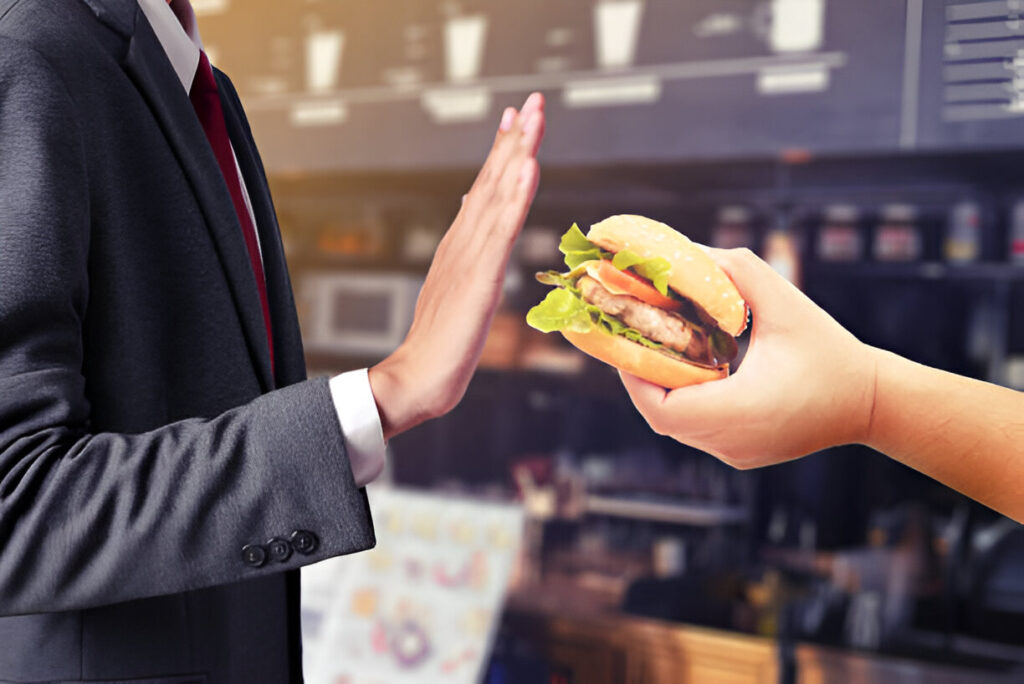Fast food injuries – whether burns, foodborne illnesses, or slip-and-fall accidents – can happen to anyone. Restaurants are legally required to maintain safe environments, but when they fail, you have rights. Here’s a quick breakdown:
- Common Injuries: Slip-and-falls, burns from hot food/drinks, food poisoning, and equipment-related accidents.
- Immediate Steps: Seek medical help, file an incident report, gather evidence (photos, witness info), and document everything.
- Legal Rights: Restaurant owners must ensure safety. Liability may extend to property owners, equipment manufacturers, or food suppliers.
- Compensation: Covers medical bills, lost income, pain, and long-term damages.
- Get Help: Consult a personal injury lawyer experienced in restaurant cases and avoid settling for low offers.
Taking quick action and knowing your rights can help you recover and secure fair compensation. Read on for detailed steps and examples.
Types of Fast Food Restaurant Injuries
Fast food restaurants come with their own set of risks for both customers and employees. Knowing the most common types of injuries can help pinpoint potential hazards and put safety measures in place. Below are some typical injury scenarios that occur in these environments.
Slip and Fall Accidents
Slip and fall incidents are a leading cause of injuries in fast food establishments. In 2019, these accidents accounted for 27.5% of 888,220 nonfatal workplace injuries. They often happen in areas like drink stations or entrances, where floors are prone to becoming slippery due to spills or cleaning. These accidents can result in serious injuries and lost workdays.
Hot Food and Drink Burns
Burns are another frequent issue, especially with hot food and beverages. For instance, in March 2023, a 15-year-old McDonald’s employee in Tennessee suffered burns while handling hot oil to remove french fries – an action that violated labor laws for minors.
Food Safety Issues
Food safety problems can lead to severe health risks and legal claims. According to the CDC, foodborne illnesses impact about 48 million Americans each year, with 128,000 requiring hospitalization. In fast food settings, these illnesses often stem from improper food handling, contamination, or poor temperature control. Restaurants reported 489 foodborne disease outbreaks, highlighting the scale of the problem.
Equipment-Related Injuries
Faulty or misused equipment can lead to serious injuries. In one case, a baby was scalded by hot water at an Applebee’s in Queens, NY, when a server placed a glass of water on the family’s table, causing a dangerous situation.
Recognizing these risks is the first step toward addressing them. The following section will cover the immediate actions to take if you’re involved in one of these incidents.
What to Do After an Injury
Taking the right steps immediately after an injury can safeguard both your health and any potential legal claims.
Get Medical Help
Your health should come first after an injury. Even if your injuries seem minor, they can get worse without proper care. Seek medical attention right away – go to the emergency room for serious injuries or an urgent care clinic for less severe ones. This not only ensures you get the treatment you need but also creates an official record of your condition.
Keep all medical records, including:
- Notes from your initial visit to the emergency room or urgent care
- Follow-up appointment records
- Prescriptions and treatment plans
- Medical bills and related expenses
File an Incident Report
Report your injury to management as soon as possible to establish an official record. When doing so:
- Get the manager’s full name and contact details
- Request a copy of the incident report for your own records
- Record the date and time of the report
- Stick to the facts – don’t make statements about fault or liability
Record Evidence
Gather as much evidence as possible to document the incident. Take photos of the scene, your injuries, and any hazards. Note details like the time, location, conditions, and any warning signs present.
Find Witnesses
If others were present, collect their information and ask for brief written statements. Be sure to include:
- Full names and contact information
- A short summary of their account of the incident
- Their connection to the event (e.g., customer or employee)
Avoid discussing fault or liability with witnesses, as this could complicate your case.
Legal Rights in Restaurant Injuries
Fast food restaurants have a responsibility to keep customers safe. Knowing your rights can help you figure out when and how to seek compensation if you’re injured on their property.
Property Owner Responsibilities
Restaurant owners are expected to ensure their premises are safe for customers. This involves regular inspections, fixing hazards promptly, and using clear warning signs. They must address both obvious dangers and risks that could be identified through reasonable checks. Strict safety rules are also in place to minimize risks for customers.
Restaurant Safety Requirements
Fast food restaurants must meet specific safety standards in several key areas:
| Area of Focus | Requirements |
|---|---|
| Food Safety | Proper storage temperatures, preventing contamination, and employee hygiene |
| Premises Safety | Non-slip floors, good lighting, clear pathways, and proper warning signs |
| Equipment Safety | Regular maintenance, safety guards, and temperature controls |
| Emergency Systems | Functional fire suppression, marked exits, and accessible first-aid kits |
Who Is Responsible
Liability is about determining who is at fault when safety measures fail. This often includes:
“Legal liability alone can serve as an economic signal to deter firms from producing unsafe food and… can also serve as an indirect regulator promoting food safety.” – University of Colorado Law School
- Restaurant Owners/Operators: Responsible for keeping the premises safe and following safety protocols.
- Property Owners: If different from the restaurant operator, they are accountable for structural safety.
- Equipment Manufacturers: Liable for injuries caused by defective equipment.
- Food Suppliers: Must provide uncontaminated ingredients.
For example, William Kidd suffered a traumatic brain injury after slipping in an El Pollo Loco restaurant in Bakersfield, California. The jury found the restaurant at fault and awarded him over $16 million in damages.
The “mode of operation” doctrine also plays a role, especially in self-service areas where spills and hazards are more common. Under this rule, restaurants can be held liable for injuries even if they weren’t aware of a specific hazard, as long as the business model created a foreseeable risk.
Getting Compensation
After addressing the immediate aftermath of a fast food injury, building a solid case is key to securing fair compensation. This can help cover your recovery costs and protect your future.
Types of Payment Available
Injury claims can include various forms of compensation to address both short-term and long-term effects. Here’s a breakdown:
| Compensation Type | What It Covers |
|---|---|
| Medical Expenses | Current treatments, future procedures, and rehabilitation costs |
| Lost Income | Wages lost due to missed work or reduced earning ability |
| Pain & Suffering | Physical pain and emotional distress |
| Out-of-Pocket Costs | Expenses like transportation to appointments or the purchase of medical equipment |
| Permanent Damages | Scarring, disabilities, or other lasting physical limitations |
Building Your Case
To strengthen your case, you’ll need:
- Medical Records: Retain all documentation from emergency visits, follow-ups, and any ongoing treatment.
- Evidence and Witnesses: Collect photos, videos, and witness contact details to support your claim.
- Expert Testimony: Medical professionals can validate the severity of your injuries and their potential long-term effects.
“We’ll fight to ensure you receive the compensation you deserve for your injuries, medical expenses, lost income, and emotional distress.” – Morgan & Morgan
For instance, in 2023, Morgan & Morgan attorney Ben Welch secured a $3 million settlement from Dunkin’ for a retired government worker who suffered severe burns caused by an unsecured coffee lid. This win was achieved through detailed documentation and expert testimony.
Dealing with Insurance
Insurance companies often aim to reduce payouts, so handling negotiations wisely is crucial.
- Initial Contact
Avoid giving recorded statements without legal guidance. Stick to basic facts about the incident and avoid discussing fault or injury details. - Settlement Negotiations
Insurance adjusters typically start with low offers. Take the 2017 Starbucks case involving Joanne Mogavero as an example. Initially, Starbucks denied liability, but evidence, including 80 monthly lid complaints, helped secure a $100,000 verdict. - Documentation Requirements
Keep thorough records of all conversations with insurance representatives. Always request written confirmation of offers or agreements and save copies of submitted documents.
Since insurers prioritize minimizing costs, consulting a Wendy’s personal injury attorney experienced in restaurant-related cases can help ensure you receive the compensation you’re entitled to.
Where to Get Help
Getting the right support after a fast-food restaurant injury can make a big difference in your recovery and in pursuing compensation. Here’s how to find the help you need.
Choosing a Lawyer
Look for a lawyer who has experience with restaurant injury cases. Key factors to consider include:
- Their track record with restaurant-related claims
- Resources to take on large fast-food chains
- Licensing in your state
- Free initial consultations
- Working on a contingency fee basis
For instance, firms like Van Law Firm and Anderson Law, PLLC in Washington state offer free consultations for restaurant injury cases. This allows you to discuss your situation without any upfront costs. Both firms have handled claims involving major fast-food chains.
Support Organizations
Beyond legal help, support organizations can assist in your recovery. The Trauma Survivors Network (TSN) provides both virtual and local support groups. These groups offer emotional support, practical advice, and resources for your family.
Legal Information Sources
Online platforms can help you understand your rights and build a stronger case. For example:
- FindLaw’s Accidents and Injuries section covers state-specific injury laws, product liability, restaurant safety rules, and legal precedents.
- LegalMatch connects you with pre-screened attorneys based on your injury type, location, and case details.
Make sure to focus on resources specific to your state, as injury laws and compensation rules differ by jurisdiction. Keep detailed documentation of everything, including correspondence with lawyers and support organizations. These steps will help you prepare for the road ahead and protect your rights.
Next Steps
Time is critical – if you’re in states like California or Illinois, make sure to file your lawsuit within two years[2].
Take detailed records of your accident. Snap clear photos of the scene, your injuries, and any hazards. Keep your receipt and gather contact details from witnesses.
Avoid accepting low settlement offers right away. Let your attorney handle the negotiations so you can focus on your recovery.
Be cautious about what you post online. Sharing details about your injury or recovery on social media can harm your case. Insurance companies often monitor these platforms and may use your posts against you.
If you need help with legal paperwork or procedures, check out these government resources:
- The Occupational Safety and Health Administration (OSHA): Offers guidance on workplace safety standards.
- Your local court library: Provides access to legal research materials.
- The Centers for Disease Control and Prevention (CDC): Shares information on food safety and injury prevention.



